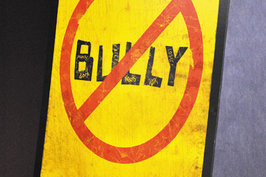The hot-button issue documentary “Bully” opens with a moving, heartfelt speech by David Long, who describes his teenage son Tyler being victimized and bullied. Tyler was a loner who finally decided, David recounts, “enough was enough.” The film later reveals that Tyler hung himself to end the painful emotional abuse he suffered as a teenager.
Another subject, Kelby, a 16-year-old lesbian in Oklahoma (see sidebar Q&A), poignantly confesses that she was a cutter and attempted suicide three times as a result of bullying in her school.
In contrast, Ja’meya, a 14-year-old African-American girl in Mississippi, responded to her abusers by drawing a gun on the school bus. Her actions landed her in a juvenile detention center, where she faced multiple felony counts.
These powerful stories are representative of how teens respond to being teased, tortured and tormented in middle and high schools across America. “Bully” is a response — and a blistering wake-up call — to the estimated 13-million kids mentally and physically abused by their peers every year.
Yet while the film has some important insights about bullying — how kids who are picked on respond to it, how administrators in schools are seemingly unable to do anything about it, and how angry parents are that it happens to their children — director Lee Hirsch’s deliberately observational approach to the subject almost does his topic a disservice. He does not focus on the bullies but rather on the victims (and their families), to show how they are weakened further by a system that cannot solve their problems. Administrators shrug off concerns with a “kids will be kids” attitude. One anger-inducing episode has a student complaining to an ineffectual assistant principal, Kim Lockwood, that he is being abused. Her infuriating response is to tell the troubled student, “Maybe you can be friends.” That bullying is brushed aside by administrators like Lockwood, as if it is a rite of passage, is particularly frustrating, however accurate it is.
The film concentrates mostly on presenting the problem. But who watching this documentary doesn’t already understand that bullying is a problem?
“Bully” does include two interesting anecdotes by kids who overcame bullying, illustrating that behavior can change. One boy, Devon, explains how he stood up to his bullies, and that earned him their respect. Another pre-teen, named Trey — who is grieving the loss of his best friend, who committed suicide — explains how he used to be a bully, but has since mended his ways.
In marked contrast, Kelby’s decision to stay in her school and not let the bullies “win” proves to be unwise. Yet “Bully” barely shows viewers why, and this is a missed opportunity.
Kelby’s screen time is minimal in the film. Most of “Bully” — too much, in fact — follows the trials and tribulations of Alex, a gawky 12-year-old who is viciously picked on by his classmates on the school bus. They strangle him from behind, stab him with pencils and punch him as well as call him names. “Bully” films these horrifying episodes and viewers will want someone to step in and save poor Alex. No one does, but the filmmakers do show the footage to Alex’s parents and school officials — who are justifiably disturbed. One of the saddest moments in “Bully” has Alex’s mother explaining to him that the kids who abuse him are not his friends; Alex does not quite realize this. His parents try to get the school to take control of the situation and monitor the behavior of the other kids, but his mother feels her complaints fall on deaf ears.
More forceful is a town hall meeting where Long and his wife try to address the issue of bullying. They find incredible support in community members and fellow students, if not the school board members attending the same meeting.
If “Bully” is painful to watch as kids like Alex are physically abused, or a young boy named Cody tells a teacher that it “breaks my heart” to be called a “faggot,” the articulation of their suffering is effecting. Even viewers who have never been bullied will feel for these kids who do not deserve such cruelty.
Yet despite its noble intentions to call attention to a larger problem, “Bully” never addresses how these kids can seek/find help, or even get counseling to deal with their problems. Ja’meya is the exception, but only because her counseling is court-ordered.
“Bully” also introduces Kirk and Laura Smalley, a couple whose 11-year-old son killed himself as a result of bullying. Kirk starts a program called “Stand for the Silent” to raise awareness for what his late son endured. It’s an important project and one that the film shows gaining momentum.
But “Bully” really should have addressed how kids can be protected and prevented from taking their own lives. It needs to teach coping skills for being different and feeling isolated. Telling their stories, however brave, inspiring and empowering, is only the start of the conversation. It is not enough.

